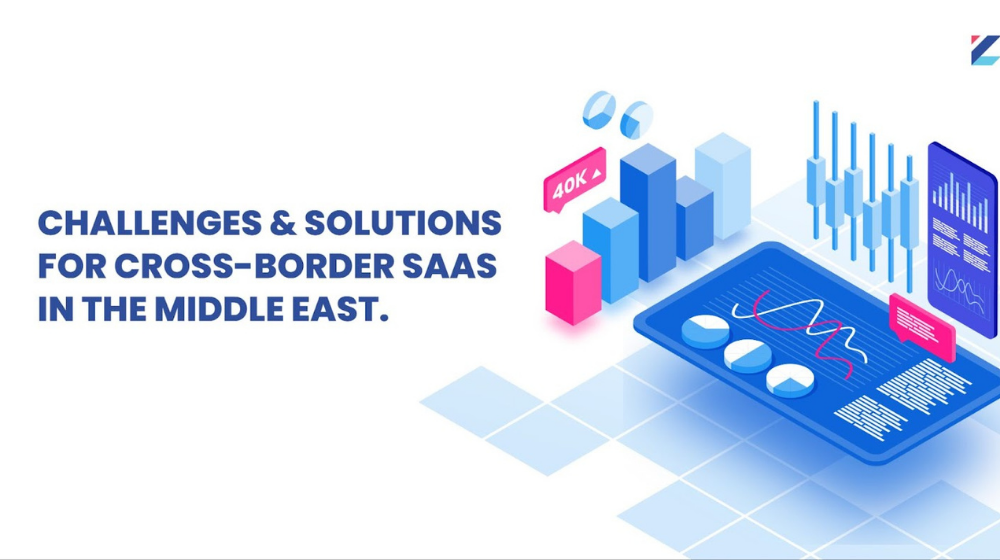The global Software as a Service (SaaS) market is projected to reach a staggering $883.34 billion by 2029.
The Middle East and Africa (MEA) are expected to experience moderate to high growth, underscoring the immense potential of emerging markets.
According to a report by Bluewave Consulting from 2023 to 2029, the UAE’s SaaS market is expected to expand at a 27.93% CAGR, reaching USD 30.52 billion by 2029.
With SaaS becoming one of the major trends in the digital transformation landscape of the Middle East, cross-border Software as a Service (SaaS) solutions are emerging as critical drivers of this transformation, offering unparalleled advantages such as operational efficiency, scalability, and cost-effectiveness to businesses within the region.
However, penetrating the Middle Eastern market isn’t easy! In this blog we will talk about the Challenges and Solutions for Cross-border SaaS in the Middle East.
Let’s get started!
What is cross-border SaaS in the Middle East?
Cross-border SaaS is the delivery of software as a service (SaaS) to customers in a different country than the SaaS provider is headquartered in. This can be a complex process, as there are often regulatory, cultural, and technical challenges to overcome.
Challenges for Cross-border SaaS in the Middle East
Cross-border Software as a Service (SaaS) companies targeting the Middle East face several challenges due to the region’s unique and diverse business environment, regulatory landscape, and cultural differences. These include
- Regulatory compliance:
Each country in the Middle East has its own set of data protection and privacy regulations. SaaS providers need to ensure that they are compliant with all relevant regulations in the countries where they operate.
- Payment processing:
It can be difficult to process payments from customers in the Middle East, as there are a number of different payment methods and currencies in use. SaaS providers need to find a payment processor that supports the payment methods used by their target customers.
- Localization:
SaaS providers need to localize their products and services for the Middle East market. This includes translating their products into Arabic and other local languages, and adapting their products to meet the cultural needs of the region.
- Technical infrastructure:
The quality of internet access and technical infrastructure can vary widely across the Middle East. SaaS providers must ensure that their products and services can be accessed and used reliably by customers in the region.
- Data Privacy and Security Concerns:
The region has strict and varying data protection laws. Navigating and complying with these, particularly around data residency and sovereignty, can be complex and demanding for SaaS providers.
- Local Presence and Partnerships:
Establishing a local presence or securing partnerships with local entities can be daunting due to different business practices and norms but is often essential for gaining market trust and navigating the business landscape effectively.
- Customer Expectations and Behavior:
Understanding and adapting to the unique expectations, behaviors, and needs of Middle Eastern customers is crucial. This may involve offering tailored features, pricing models, and customer support.
- Economic and Political Instability:
The economic and political environment can be volatile in some countries within the Middle East. This instability can impact business operations, demand, and the overall feasibility of offering SaaS solutions in the region.
- Brand Perception and Trust:
Building a reputable brand that resonates with local values and gains the trust of businesses and consumers in the region is challenging but essential for long-term success.
- Tariffs and Trade Barriers:
Cross-border SaaS companies might face high tariffs, strict import/export regulations, and other trade barriers when entering the Middle Eastern market
Solutions for Cross-border SaaS in the Middle East
Despite these challenges, there are a number of opportunities for SaaS providers in the Middle East. The region is experiencing rapid economic growth and a growing demand for cloud-based services. Additionally, the Middle East has a young and tech-savvy population, which is a good target market for SaaS providers.
These are the number of solutions that SaaS providers can implement to overcome the challenges of cross-border SaaS in the Middle East. These include:
- Partnering with local companies:
Partnering with local companies can help SaaS providers to overcome regulatory and cultural challenges. Local partners can also help SaaS providers to process payments and localize their products and services.
- Using cloud-based infrastructure:
Using cloud-based infrastructure can help SaaS providers to overcome challenges with technical infrastructure. Cloud providers such as AWS, Azure, and GCP have data centers in the Middle East, which can provide SaaS providers with reliable and high-performance infrastructure.
- Focusing on specific industry verticals:
SaaS providers may find it easier to succeed in the Middle East by focusing on specific industry verticals. This allows them to tailor their products and services to the specific needs of their target market.
- Enhancing Security Measures:
To instill trust among users in the Middle East, SaaS providers need to prioritize the security of their platforms. Adhering to international security standards and showcasing transparency in data handling practices can help build user confidence and ensure compliance with local data protection laws.
- Customizing Pricing Strategies:
Adapting pricing strategies to reflect the economic diversity in the Middle East can assist in capturing a broader market. Competitive pricing, localized payment options, and various subscription models can cater to different customer segments and drive adoption.
- Providing Robust Customer Support:
Offering excellent customer support, tailored to the local time zones and languages, can significantly enhance user satisfaction and retention. Having support staff familiar with local customs and languages can ensure clearer communication and quicker resolution of issues.
- Ensuring Mobile Compatibility:
With a high mobile penetration rate in the region, optimizing SaaS products for mobile users is crucial. A mobile-friendly interface and potentially a dedicated app can enhance user experience and accessibility, catering to the predominant user behavior in the region.
- Investing in Market Research and User Education:
Understanding the unique needs and preferences of the Middle Eastern market through extensive research can inform product development and marketing strategies. Educating users on the value proposition of the SaaS product can also drive adoption, especially in markets that are relatively new to SaaS products.
- Acquiring Local Certifications and Licenses:
Securing relevant certifications and licenses from local authorities can enhance credibility and facilitate smoother operations. These accreditations serve as endorsements of the quality and reliability of the SaaS offering, fostering trust among potential users and partners.
- Implementing Flexible Contractual Agreements:
Adapting contractual terms to respect local business practices and legal frameworks can facilitate smoother negotiations and partnerships. Flexible and clear agreements can help in aligning expectations and preventing potential conflicts.
Cross-border SaaS in the Middle East presents unique challenges and significant opportunities. By following the tips and solutions outlined in this blog post, SaaS providers can increase their chances of success in this exciting market.
How can Zoftware Facilitate Smooth Cross-border SaaS in the Middle East?
Zoftware is Middle East’s First and Biggest Software Discovery Platform. Being one of the premier software discovery platforms, we act as a medium between software firms and prospective buyers, emphasizing the dynamic market of the MENA region.
We streamline the process for software businesses to connect with the appropriate System Integrators and Software resellers, utilizing profound, established connections with local MSMEs to enhance business expansion.
Moreover, we provide robust support infrastructure and precise implementation services facilitated by system Integrators on our platform, enabling international software companies to smoothly and efficiently operate within the Middle East.
- Market Access and Penetration:
Zoftware offers software vendors an efficient pathway to access and penetrate the challenging Middle East market, characterized by its unique business landscape and customer behavior.
- Customer Acquisition:
Thanks to its comprehensive database of potential software buyers, Zoftware’s platform offers vendors a direct line to prospective customers, reducing acquisition costs and effort.
- Brand Visibility:
Vendors can leverage Zoftware’s vast user base of businesses seeking software solutions to enhance their brand visibility and recognition.
- Targeted Marketing:
Zoftware enables vendors to present their products to businesses actively seeking software solutions, improving conversion rates through such targeted exposure.
- Partnership Opportunities:
Zoftware connects vendors with system integrators and software resellers, opening doors to partnerships that can extend vendors’ market reach and boost sales.
- Feedback Loop:
Vendors receive valuable feedback and insights from end-users, aiding in product refinement and better alignment with market needs.
- Cost-Effective:
Zoftware’s comparison and recommendation platform eliminates the need for heavy investments in marketing and promotional activities, rendering customer acquisition more cost-effective.
The future of cross-border SaaS in the Middle East looks promising! If you are looking forward to penetrating the Middle Eastern SaaS market and establishing a robust digital footprint. Contact us today!





